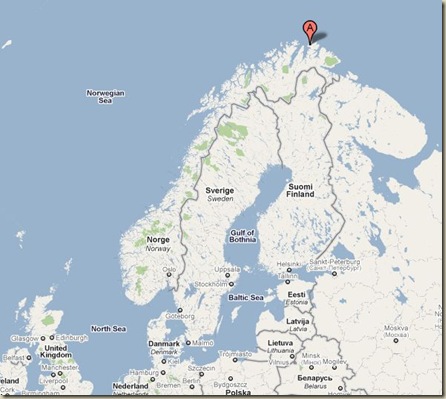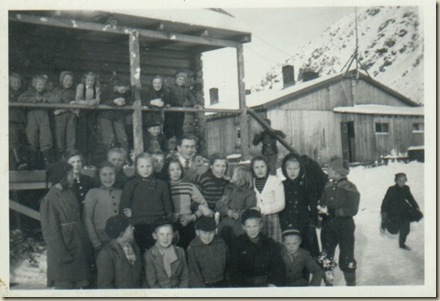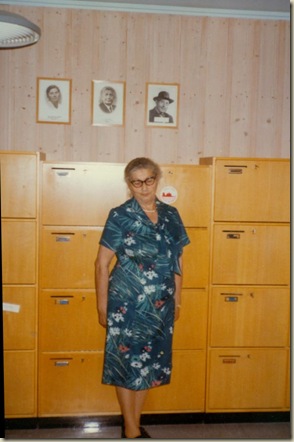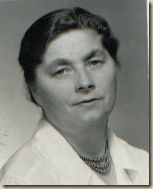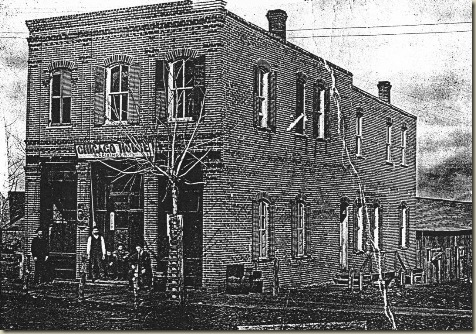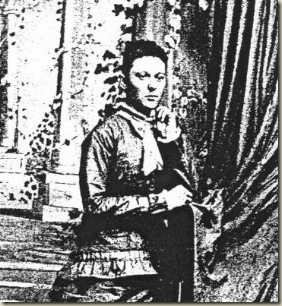First, I’d like to thank Jenn at Your Growing Tree for the idea of Future Friday. The idea is to get us thinking about helping future generations to know *us*. I’ve taken some time to evaluate all of my current genealogical “goodies” and have picked one particular area of focus: family stories and biographies.
More and more, genealogy-related documents and transcriptions are making their way online. Twenty years from now, finding facts about individuals in our family trees will probably be easier than ever. But finding personal information about these people – likes, dislikes, habits, hobbies, personality traits, life experiences, etc. – will be equally as hard without someone recording this information now. To address this in my own family, I have set a few of goals for 2011:
1) Take the time to jot down a few notes about my more “recent” ancestors, those whom I knew personally, or knew through family stories. To keep this goal a realistic one, I am not going to write formal biographies, but instead will concentrate on recording as much as I can about as many people as possible. I (or someone else) can always take the time to write a more “polished” biography in the future.
2) Complete a personal biography. No amount of documents can help you get to know an ancestor like an autobiography. I had resisted doing this for my own life, primarily because I don’t think I’m that interesting. However, several of the personal biographies I have begin with, “I’m only writing this because my daughter insists,” or “I don’t understand why anyone would ever want to read this, but...” so perhaps it will be the same with my story and my descendants. I was inspired by OurStory.com, a free site that allows collaboration among people in getting stories and timelines recorded. (I have no affiliation whatsoever with this site, nor its creators.) While I don’t feel compelled to put my stories online, they do offer a number of “question sets” that were easy to use and were very effective in reviving old memories. I started writing my story several years ago, and set it aside when life got busy. This coming year, I’m going to attempt to get it up to date, or at least make some significant progress.
This would also be a great “group activity” if you’re getting together with siblings, cousins, etc., for the holidays. What great fun it would be to get a bunch of them together, with a pot of coffee, a digital recorder, and one of these question sets! The result would be a priceless gift for our descendants.
There are many other ways in which a family historian could assist future generations, but with a limited amount of time available, this is what I will be tackling. Did I just make a New Year’s Resolution??

Friday, December 17, 2010
Wednesday, December 15, 2010
Wedding Wednesday – 47 years later
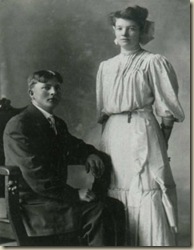
In her diary entry of Saturday, March 30, 1957, my great grandmother Virta Knutz recalled the day she married her husband Will:
“47 years ago today we were married and such a day as it was; it rained, hailed, wind blew hard and it blizzarded all before noon but that did not stop me; Delbert [her brother] took me to the depot and waited with me till the train came; I had to go to Huron (from Esmond) to meet Will. Henry Thompson and his girl Stella were there to be married at the same time we were; we were witnesses for each other. We ate our dinner in a hotel which is now torn down and there is a gas station and truck parking lot there now. After dinner we were married and did some shopping and drove home; we used horse and buggy those days, had to drive about 7 miles; got home I got my first meal for us; which was (as I remember) bacon and eggs and potatoes.”

Above: Their marriage certificate
They would celebrate eight more anniversaries together before Will’s death in 1966.
Saturday, December 11, 2010
The End of an Era, Rapidly Approaching
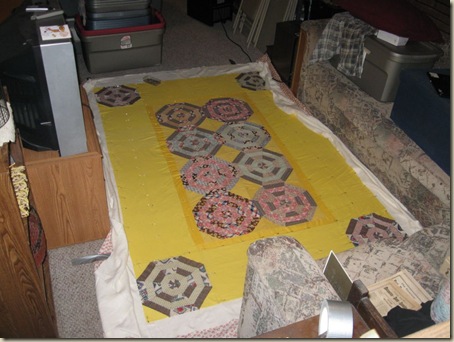
Tonight I’m feeling a bit wistful at the thought of finally completing my grandmother’s quilt. It’s been a project that on one hand, I have treasured, but on the other hand, has had me terrified – terrified that the finished product would not be something that my grandmother would have liked, or that I would not be up to completing the task correctly.
There have been some major hurdles – trying to decipher the pattern for the blocks by trial and error - coming up with a design that incorporated both my grandmother’s blocks, and my aunt’s dark gold border around them - finding era-appropriate fabric - and making that fabric look “old” so that it would blend in with the 1940s feed sacks my grandmother used. These problems solved, I was making good progress reproducing the blocks until I figured out a way to “improve” them, and ultimately rendering most of them unusable in the process. Frustrated, I set the project aside for more than two months. I finally got inspired again last night and salvaged four of the blocks, to complete the corners. I was able to keep the dark gold border done by my aunt, thereby making this a “three generation quilt.”
This evening, as I pin-basted the quilt to the batting and backing, listening to the howling wind and snow outside, I thought of the first quilt I ever made – a Dresden plate made from another grandmother’s blouses. It, too, was basted on what was (up until tonight) the worst blizzard we’ve had since moving here, twenty-some years ago. It seems I do my most significant work while the snow piles up outside.
Basting completed, it will next be hand-quilted, once I come up with a design. I’ve jumped the most difficult hurdles with the quilt and it should be easy enough from this point on, which almost makes me a little sad. After 70 years, and three generations, the quilt is nearly complete. It will be the end of an era.
Wednesday, November 24, 2010
100th COG Edition - There's One In Every Family: The Upbuilding of a School District
On the northern coast of the Land of the Midnight Sun, in the village of Kjøllefjord, a school system was built up from nothing to a thriving environment for learning, by a woman I’m proud to call my grandmother.
The year was 1925, and 23 year old Lise Klungseth had just graduated from teacher’s college in Oslo, and like every other graduate, was looking for a job. The market was flooded, and teaching positions were generally hard to come by. However, Lise had read about Finnmark, and the work of Pastor Otterbeck, who was trying to bring Christianity to the laplanders and Finlanders in the area, many of whom did not speak Norwegian. There weren’t many teachers willing to go there because, as Lise put it, there were times “when the sun does not shine for two months,” and the area was nowhere near as cultured as southern Norway. She described Kjøllefjord as “about as far away from home as you can get.”
Lise soon found herself employed in one of the poorest districts in Finnmark. Her teaching position was split between three different schools, one month at each place, traveling between them by boat. Her schoolhouses consisted of single rooms in private houses, with no books, pencils or papers. Lise provide what they needed out of her own pocket. Eventually, she was “promoted” to only having two schools.
Once there, they were able to arrange for a log cabin, which had served as a hospital during the war, to use as their schoolhouse. The mayor of the village asked Lise what she needed – she asked for carpenters, and was given them. She worked alongside them, finishing the rooms and commencing her classes. She taught from 8:30 a.m. until 8 p.m. She was able to get three students from Oslo to come and help with the teaching duties. They made do with whatever supplies they could find, until one day a mysterious box, sent from Canada, arrived at the school, filled with paper and pencils. More boxes followed – with books! They never did find out who sent those badly needed supplies, but they were grateful beyond words.
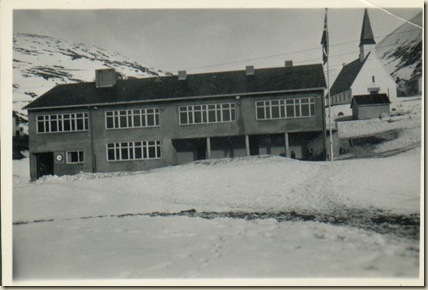
Lise continued to build up the school, and was eventually promoted to Principal, with six teachers employed, a new and modern schoolhouse, complete with an intercom system, among other "luxuries.”
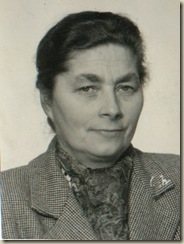
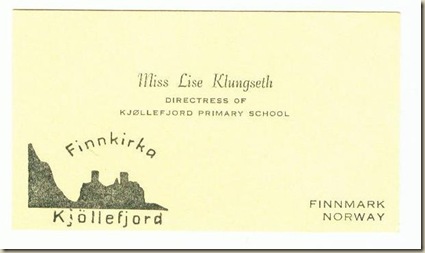
Her life was diverted from the children of Kjøllefjord in 1952, when she received a letter from my widowed grandfather, who was a lifelong friend, asking her to come to the United States. She did, and the rest is history. But I’m certain that leaving Kjøllefjord, where she had invested so much of herself, was probably one of the hardest things she had ever done. She left behind her permanent gift to that village – an educational system to be proud of.
The year was 1925, and 23 year old Lise Klungseth had just graduated from teacher’s college in Oslo, and like every other graduate, was looking for a job. The market was flooded, and teaching positions were generally hard to come by. However, Lise had read about Finnmark, and the work of Pastor Otterbeck, who was trying to bring Christianity to the laplanders and Finlanders in the area, many of whom did not speak Norwegian. There weren’t many teachers willing to go there because, as Lise put it, there were times “when the sun does not shine for two months,” and the area was nowhere near as cultured as southern Norway. She described Kjøllefjord as “about as far away from home as you can get.”
Lise soon found herself employed in one of the poorest districts in Finnmark. Her teaching position was split between three different schools, one month at each place, traveling between them by boat. Her schoolhouses consisted of single rooms in private houses, with no books, pencils or papers. Lise provide what they needed out of her own pocket. Eventually, she was “promoted” to only having two schools.
When World War II broke out, the people of Kjøllefjord had to run for their lives. Lise went back home to her parents’ home, and the following spring, to her sister’s home in Trondheim, where she was offered a very good teaching job. While there, she received a telegram from the director of schools in Finnmark, asking her to return to Kjøllefjord. Recalling what little she had to work with there, she asked: Do you have a schoolhouse? No. Do you have desks for the children to sit on? No. Do you have books? No. What do you have? Children.
Something inexplicable led her to say yes, quit her job in Trondheim, and head north. She said, “I was the happiest person in the world, just like everybody else who was coming back because the Germans were gone, the country was ours and we were able to build it up again.” Once there, they were able to arrange for a log cabin, which had served as a hospital during the war, to use as their schoolhouse. The mayor of the village asked Lise what she needed – she asked for carpenters, and was given them. She worked alongside them, finishing the rooms and commencing her classes. She taught from 8:30 a.m. until 8 p.m. She was able to get three students from Oslo to come and help with the teaching duties. They made do with whatever supplies they could find, until one day a mysterious box, sent from Canada, arrived at the school, filled with paper and pencils. More boxes followed – with books! They never did find out who sent those badly needed supplies, but they were grateful beyond words.

Lise continued to build up the school, and was eventually promoted to Principal, with six teachers employed, a new and modern schoolhouse, complete with an intercom system, among other "luxuries.”


Her life was diverted from the children of Kjøllefjord in 1952, when she received a letter from my widowed grandfather, who was a lifelong friend, asking her to come to the United States. She did, and the rest is history. But I’m certain that leaving Kjøllefjord, where she had invested so much of herself, was probably one of the hardest things she had ever done. She left behind her permanent gift to that village – an educational system to be proud of.
Lise, on a visit back to her old school in Kjøllefjord, in the 1980s. Notice her picture on the wall, at left, a copy of which is below.
The Pink Bowl

The pink Stetson Melmac bowl has been a part of our Thanksgiving tradition as far back as I can remember. It belonged to my maternal grandmother, and only on special occasions did she take it from its designated spot in the buffet. We would sit around the large oak pedestal table, all the leaves having been added to accommodate the four generations. Grandpa was seated at the head of the table, and the three kids would fight over the two chairs on either side of him. I vividly remember staring at the bowl from my place at the table, being too short to see inside, and wondering what deliciously wonderful surprise Grandma had put in it, as it was passed from person to person. Sometimes it was mashed potatoes, sometimes a vegetable dish, sometimes it was fruit salad. Didn’t matter. Anything she cooked was especially tasty, but there was something about that pink bowl... the sight of it still makes my mouth water in anticipation.
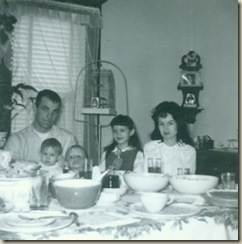
After Grandma passed away in 1991, my sister and I were sharing our precious memories of dinner around her holiday tables, when Grandpa surprised us by telling us to take the bowl home. I like to think I would have insisted my sister take it, but thankfully, it was not an issue. We were delighted to discover there were actually *two* pink bowls, as pictured in the photo above, side by side. Now, at each “pink bowl occasion”, we compare notes about what will be served in them, hundreds of miles apart.
It’s hard to imagine a Thanksgiving without the pink bowl, and the precious and comforting memories of times past.
Friday, October 22, 2010
Civilian Conservation Corps Records
The Civilian Conservation Corps, one of the most popular New Deal programs of President Franklin D. Roosevelt, offered jobs to unemployed young men. Most of them, aged 18-24, were from families on public relief during the Great Depression, and had few other prospects for employment. Some three million of them applied, passed a physical, and made their promise of a minimum 6 months’ service, before they were sent to work constructing parks, planting trees, working on public roadways, and constructing buildings on public lands. In return, they were given room and board, plus a small wage. They were required to send money to their families back home.
I had heard that my father-in-law, Bob, had taken a job with the C.C.C. when a young man, but had no details. While we know a fair amount about his life, the years from 1930 to 1950 were somewhat fuzzy. I contacted the National Personnel Records Center in St. Louis several times inquiring about records before finally receiving an answer informing me that his records were available. I filled out the paperwork required, sent in $60, and waited. Within two weeks, I had a packet of about a dozen pages of information. I was hoping what I found was worth the cost and the persistence.
Through the information found in these records, in addition to information I already had, I was able to put together a fairly good timeline. The family moved from Hand County, South Dakota to Spearfish sometime in 1937. Bob attended his first year of high school in Spearfish, but went to work at the Red Owl Grocery store in January of 1938 as a “helper”. He worked there three months, and was unable to find another job until his enrollment in the C. C. C. in July.
He was AWOL for 3 days after Christmas in 1938, and “AWOP” for five days after that, all for unknown reasons. He was “Absent With Out Pay” from 6/19/1939 (the day his step-father passed away) to 6/26/1939 (when he was discharged) for “Emergency Leave”. Before the year was out, Bob, his mother, and his siblings had relocated back to their home in Hand County.
I learned a few personal details about Bob that I had not known. He was barely 17 when he quit high school to go to work, but during his first three months with the Corps, he expressed interest in completing some high school coursework. Had he put aside his own education to help his family financially? Or had he quit school for other reasons? The interest in completing high school was apparently still there.
I learned that Bob considered himself best suited for work as a mechanic, but was hoping to work as a traveling salesman after completion of his C. C. C. enrollment. While he did work at implement and hardware stores, he never did sell his wares on the road.
I didn’t know he was small kid - 5’5” and 124 pounds – when entering the C. C. C. camp. Upon his discharge a year later, he had grown an inch, and gained 11 pounds. Later photos of him depict a slightly stocky build.
He was called “honest and reliable” by his camp adviser, and described as an “able and dependable workman.” He enjoyed reading while at the camp.
While the C. C. C. file did not reveal any surprising news, it did present a snapshot in time of Bob’s youth, his interests and abilities, and his character. Since he died young, learning these little bits of information from whatever sources we can find is especially important, as there aren’t many people left who knew him directly, particularly at this stage in his life.
Some of the more interesting pieces of information in the file, besides the basic birth date, birth place, and address, included an educational and work history. Results of the physical exam were also in the file. Work preferences, as well as the kind of work actually done, was also noted.
To find if your Great Depression era ancestor has C. C. C. records available, write to the National Personnel Records Center, Civilian Personnel Records, 111 Winnebago Street, St. Louis, Missouri, 63118-4126. Be sure to include as much information as you can about your ancestor: name, birth date and place, home address, parents’ names, specific dates of C. C. C. employment, if known, and any other applicable information.
Sources:
Bailey, Thomas A., "The American Pageant: A History of the Republic", D. C. Heath and Company, Boston.
Wikipedia
Civilian Conservation Corps Legacy (www.ccclegacy.org)
I had heard that my father-in-law, Bob, had taken a job with the C.C.C. when a young man, but had no details. While we know a fair amount about his life, the years from 1930 to 1950 were somewhat fuzzy. I contacted the National Personnel Records Center in St. Louis several times inquiring about records before finally receiving an answer informing me that his records were available. I filled out the paperwork required, sent in $60, and waited. Within two weeks, I had a packet of about a dozen pages of information. I was hoping what I found was worth the cost and the persistence.
Through the information found in these records, in addition to information I already had, I was able to put together a fairly good timeline. The family moved from Hand County, South Dakota to Spearfish sometime in 1937. Bob attended his first year of high school in Spearfish, but went to work at the Red Owl Grocery store in January of 1938 as a “helper”. He worked there three months, and was unable to find another job until his enrollment in the C. C. C. in July.
He was AWOL for 3 days after Christmas in 1938, and “AWOP” for five days after that, all for unknown reasons. He was “Absent With Out Pay” from 6/19/1939 (the day his step-father passed away) to 6/26/1939 (when he was discharged) for “Emergency Leave”. Before the year was out, Bob, his mother, and his siblings had relocated back to their home in Hand County.
I learned a few personal details about Bob that I had not known. He was barely 17 when he quit high school to go to work, but during his first three months with the Corps, he expressed interest in completing some high school coursework. Had he put aside his own education to help his family financially? Or had he quit school for other reasons? The interest in completing high school was apparently still there.
I learned that Bob considered himself best suited for work as a mechanic, but was hoping to work as a traveling salesman after completion of his C. C. C. enrollment. While he did work at implement and hardware stores, he never did sell his wares on the road.
I didn’t know he was small kid - 5’5” and 124 pounds – when entering the C. C. C. camp. Upon his discharge a year later, he had grown an inch, and gained 11 pounds. Later photos of him depict a slightly stocky build.
He was called “honest and reliable” by his camp adviser, and described as an “able and dependable workman.” He enjoyed reading while at the camp.
While the C. C. C. file did not reveal any surprising news, it did present a snapshot in time of Bob’s youth, his interests and abilities, and his character. Since he died young, learning these little bits of information from whatever sources we can find is especially important, as there aren’t many people left who knew him directly, particularly at this stage in his life.
Some of the more interesting pieces of information in the file, besides the basic birth date, birth place, and address, included an educational and work history. Results of the physical exam were also in the file. Work preferences, as well as the kind of work actually done, was also noted.
To find if your Great Depression era ancestor has C. C. C. records available, write to the National Personnel Records Center, Civilian Personnel Records, 111 Winnebago Street, St. Louis, Missouri, 63118-4126. Be sure to include as much information as you can about your ancestor: name, birth date and place, home address, parents’ names, specific dates of C. C. C. employment, if known, and any other applicable information.
Sources:
Bailey, Thomas A., "The American Pageant: A History of the Republic", D. C. Heath and Company, Boston.
Wikipedia
Civilian Conservation Corps Legacy (www.ccclegacy.org)
Friday, October 15, 2010
Why Seeing it With Your Own Eyes is a Good Idea
There were a million reasons to skip stopping at the cemetery – we didn’t know where the grave was located. It was a huge cemetery. We had a lot of work to do at the library. We wanted to squeeze in a visit to another town. It was nearly lunch time. We already had a picture of the grave, supplied by a distant cousin. So, other than a haunting feeling (no pun intended) that we should stop and pay our respects, there really wasn’t a logical reason to bother.

Such was our “quick” day trip to New Ulm, in Brown county, Minnesota. We were actually going there to do some research on my husband’s Ulmer relatives, but his great-grandfather Conrad Schlechter and Conrad’s second wife Mary Fischer Schlechter, from another branch of his family, were buried there as well. After the death of Conrad’s first wife in South Dakota, he left his family and moved to New Ulm, where he met and eventually married Mrs. Fischer in 1922.
As I mentioned, we had a photo of their graves, and by looking at the background details, were able to zero in on its location rather quickly. I snapped a few pictures of my own, we paid our respects, and on the way back to the car it occurred to me to check the back of the stone, just in case there was a verse or something special on it. What I found befuddled me.
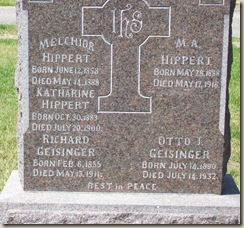
Melchior Hippert, 12 June 1858 – 14 May 1888
Katharine Hippert, 30 Oct 1883 – 20 July 1900
Richard Geisinger, 06 Feb 1855 – 13 May 1911
M. A. Hippert, 28 May 1888 – 17 May 1918
Otto J. Geisinger, 14 July 1890 – 14 July 1932
In addition, there was a small, flat stone on either side, one that read “Otto J. Geisinger, July 14, 1890 – July 14, 1932” and one that read “Mother.”
Mary was born in 1862, and died in 1938. Who were the Hipperts? And the Geisingers? I had not heard these surnames before. Were they friends from Germany? Perhaps Mary’s siblings? Why were they all buried together?
We went to the library, and I immediately began looking at census records while my husband looked through the surname file for these new names. In the next few hours, we learned that Mrs. Mary Fischer Schlechter was born Mary Dauer, daughter of Mr. and Mrs. Lorenz Dauer. She first married Melchior Hippert (1858-1888); their children were Katharine (1883-1900), Dora (1885-?), and Melchior A. (1888-1918). The year after Mr. Hippert’s death, she married Richard Geisinger (1855-1911) and had one son: Otto J. Geisinger (1890-1932). After Mr. Geisinger’s death, she married Carl Fischer. Whether this marriage ended in Mr. Fischer’s death or divorce is currently unknown. She then married Conrad Schlechter.
Besides being able to put together the pieces of this family puzzle, we learned that the Geisinger’s operated the Chicago House hotel in New Ulm, and we obtained a photo of it. In addition, we acquired a photo of Mary Dauer Hippert Geisinger Fischer Schlechter (whew!).

Such was our “quick” day trip to New Ulm, in Brown county, Minnesota. We were actually going there to do some research on my husband’s Ulmer relatives, but his great-grandfather Conrad Schlechter and Conrad’s second wife Mary Fischer Schlechter, from another branch of his family, were buried there as well. After the death of Conrad’s first wife in South Dakota, he left his family and moved to New Ulm, where he met and eventually married Mrs. Fischer in 1922.
As I mentioned, we had a photo of their graves, and by looking at the background details, were able to zero in on its location rather quickly. I snapped a few pictures of my own, we paid our respects, and on the way back to the car it occurred to me to check the back of the stone, just in case there was a verse or something special on it. What I found befuddled me.

Melchior Hippert, 12 June 1858 – 14 May 1888
Katharine Hippert, 30 Oct 1883 – 20 July 1900
Richard Geisinger, 06 Feb 1855 – 13 May 1911
M. A. Hippert, 28 May 1888 – 17 May 1918
Otto J. Geisinger, 14 July 1890 – 14 July 1932
In addition, there was a small, flat stone on either side, one that read “Otto J. Geisinger, July 14, 1890 – July 14, 1932” and one that read “Mother.”
Mary was born in 1862, and died in 1938. Who were the Hipperts? And the Geisingers? I had not heard these surnames before. Were they friends from Germany? Perhaps Mary’s siblings? Why were they all buried together?
We went to the library, and I immediately began looking at census records while my husband looked through the surname file for these new names. In the next few hours, we learned that Mrs. Mary Fischer Schlechter was born Mary Dauer, daughter of Mr. and Mrs. Lorenz Dauer. She first married Melchior Hippert (1858-1888); their children were Katharine (1883-1900), Dora (1885-?), and Melchior A. (1888-1918). The year after Mr. Hippert’s death, she married Richard Geisinger (1855-1911) and had one son: Otto J. Geisinger (1890-1932). After Mr. Geisinger’s death, she married Carl Fischer. Whether this marriage ended in Mr. Fischer’s death or divorce is currently unknown. She then married Conrad Schlechter.
Besides being able to put together the pieces of this family puzzle, we learned that the Geisinger’s operated the Chicago House hotel in New Ulm, and we obtained a photo of it. In addition, we acquired a photo of Mary Dauer Hippert Geisinger Fischer Schlechter (whew!).
The Chicago House Hotel, New Ulm, Minnesota
Mary Schlechter
The new information and photos were great, but the most valuable thing I received that day was a lesson – taking the time to consult the original, whenever possible, be it a book, document, or gravestone, is crucial. It may not always pay off in a wealth of new information, but then again, it just might.
Subscribe to:
Posts (Atom)

